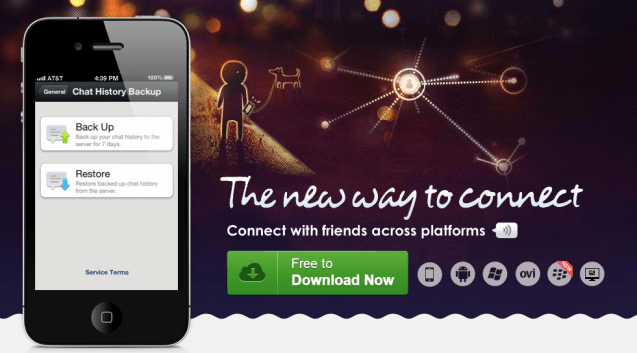China’s unprecedented growth is attracting businesses from all corners, hoping to cash in on 250 million middle class consumers. In three short decades, it has become one of the most competitive marketplaces in the world. With the average Shanghai consumer exposed to more than three times the advertising of their British equivalent, marketers need to use their marketing resources wisely to break through the clutter.
WeChat (know as Weixin in Chinese) is one of the marketing channels businesses are
finding success in reaching Chinese consumers. The mobile instant messaging service
is China’s home-grown answer to WhatsApp and, unlike many Chinese clones, it’s
innovated a few clever new features. Launching just two years ago, WeChat has already
clocked up more than 300 million users. The last 100 million users were added in less than 4
months. WeChat has become a popular way for urban Chinese communicate, and even
has China’s state-run mobile operators lobbying to enforce charges for WeChat as it is
cannibalizing so much of their revenue.

Who’s using WeChat?
China’s young, affluent and urban make up the majority of WeChat users. 74% of the
300 million are in their 20s, and as you need a smartphone to download the app, users
tend to have higher than average incomes. WeChat user profiles closely resemble
consumers who are most likely to buy foreign products and be more loyal to a brand.
What Makes WeChat an Effective Marketing Tool in
China?
WeChat provides another way to build loyalty and promote your wares to Chinese
consumers. While communications don’t have viral potential of social media services
such as Weibo, messages can be much more targeted and are almost guaranteed to
be read. WeChat messages can be text, images, sound and videos, can be location-
relevant and can be sent to groups or singles. Given 38% of Chinese smartphone users
use their mobiles more than five hours a day, checking them every six minutes on
average; your audience is well engaged. If executed well, WeChat can be an effective
way to communicate with your Chinese target market and complimentary to your other
marketing.
How best to Market on WeChat: First Off, You Need To Attract Followers
To be successful on WeChat, you need followers. Unlike some channels, most WeChat
users won’t find you through a search; it’s all about your QR Code. WeChat allows you
to simply create a QR Code allowing WeChatters to do a quick scan to become a fan.
Without overdoing it, ensure customers can find your QR Code: post it on your website,
on your packaging, social media, in your store and on your advertising – if it’s easy to
scan. WeChat also has an API that allows you to integrate the service into mobile apps
to attract followers. Be aware that consumers who follow a businesses on WeChat are
letting them into their inner circle, so you need to give them a good reason to sign up.
You can offer coupons, prizes, entertainment, pictures, WiFi access, POS promotions,
VIP treatment or support. Get creative. WeChat has some handy features such as
finding other users close by, or sending a message in the bottle to random users, as
you’ll see in some of the success stories below.
Help Your Followers Love Your Brand and Act upon it
Once you’ve got the followers, you can send communications to individual users or
specific groups. It’s a good idea to tailor your messages to make them relevant and
personal. News, coupons, offers and promotions, VIP membership, entertainment and
general pieces of interest all work well. Amongst the mass of people in China, Chinese
consumers like to feel exclusive, especially for luxury brands, and WeChat allows you
to create exclusive clusters for VIP customers. It can also provide a useful forum for
research focus groups. Soon brands will be able to offer customizable menus on their
WeChat pages to allow shopping and other features such as recommending close-by
shops. Watch this space.
Be Responsible
Remember when someone follows you on WeChat, they are letting you into their pocket
or handbag. Don’t abuse that privilege. Each time you send a message, it may interrupt
your follower and they will almost certainly read it, so make it relevant, personal and not
too frequent. Treat it like you were sending an SMS to someone, short, to the point and
not too salesy. And be aware that WeChat messaging isn’t just one-way; customers may
want to have a conversation, so ensure you have the proper resources and automated
tools to handle that.
Who’s Doing it Well?
WeChat QR-Codes are increasingly popping up across China and on the web as more
businesses hope to increase their fortunes with the channel. Here are some of success
stories of those who have:
Starbucks Songs for your Mood:
Starbucks has long been one of the pin-up kids of social media in China and its WeChat
initiatives are no exception. Starbucks’ most successful campaign utilized WeChat’s
features by asking consumers to share their mood by sending one of WeChat’s 26
emoticons to the Starbucks WeChat account. They’d then receive a song through
WeChat that reflected their mood. After a few months, 130,000 members had joined,
having shared their emotions 238,000 times. In addition, it increased awareness and
sales of their new fruity-iced drinks and increased Weibo users increase 9%.
Nike Sports Festival Game
Nike, another star of Chinese social media, was quick to jump on the WeChat wagon. At
the annual Nike Sports Festival in Shanghai, attendees could scan the Nike WeChat QR
Code to partake in a badge-collecting game that combined WeChat with the movement
tracking Nike + technology. It was a fun and interactive way to win prizes, meet sports
stars and access rich content on the Nike WeChat page. The number of registered users
grew from 1,256 on day 1 to 11,999 on day 4 as word spread, engaging a total of 22,000
consumers over the festival.
Chinese Merchant Bank Helping Autistic Kids
In a novel way to build up their fan base, CMBC used WeChat’s Message in a Bottle
feature to randomly send messages to WeChat users picking up random bottles. For
every 500 replies, the bank funded training for an autistic child in China. More than 20
million replies were received.
Cadillac Route 66
Many Chinese consumers love American culture, so Cadillac played well to that with
the classic Discover Route 66 campaign on WeChat, sending users daily updates, info
and rich content from different spots along the highway in addition to weather and safety advice.
Joy City Membership
Joy City, a popular chain of shopping malls across China, worked with more than 40 of
its food, fashion and cosmetics retailers in a WeChat campaign. Shoppers were invited
to scan the in-store QR codes to get a Joy City membership card. Once registered,
members could use their card or their smartphone for privileges such as discounts and
giveaways.
Hollywood Celebs:
With China’s movie and music industry soaring, WeChat is seeing its share of western
celebrities hoping to build their brand in China including Selena Gomez, John Cusack,
Maggie Q, Paris Hilton, Adam Lambert, Nina Dobrev and the Backstreet Boys – sending
everything from photos to sound bites wishing a Happy New Year in Chinese.
In Conclusion
While WeChat isn’t the panacea for all marketing in China, it can be an effective piece
of the puzzle to build loyalty and increase sales in one of the world’s most competitive
markets. Popularity is also soaring in other parts of Asia, so it’s a good idea to get on top
of it if you’re selling internationally.




